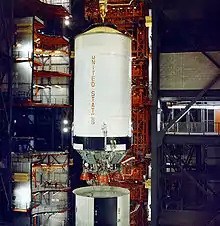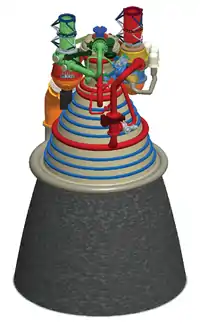S-II
The S-II (pronounced "S-two") was the second stage of the Saturn V rocket. It was built by North American Aviation. Using liquid hydrogen (LH2) and liquid oxygen (LOX) it had five J-2 engines in a quincunx pattern. The second stage accelerated the Saturn V through the upper atmosphere with 1,000,000 pounds-force (4.4 MN) of thrust.
 | |
| Manufacturer | North American |
|---|---|
| Country of origin | USA |
| Used on |
|
| General characteristics | |
| Height | 24.9 m (82 ft) |
| Diameter | 10 m (33 ft) |
| Gross mass | 480,000 kg (1,058,000 lb) |
| Propellant mass | 443,000 kg (977,000 lb) |
| Empty mass | 36,200 kg (79,700 lb) |
| Launch history | |
| Status | Retired |
| Total launches | 13 |
| Successes (stage only) | 12 |
| Other | Partial failure (Apollo 6) |
| First flight | November 9, 1967 (AS-501) Apollo 4 |
| Last flight | May 14, 1973 (AS-513) Skylab 1 |
| Rocketdyne J-2 | |
| Engines | 5 |
| Thrust | 4,400 kN (1,000,000 lbf) |
| Specific impulse | 421 seconds (4.13 km/s) |
| Burn time | 367 s |
| Fuel | LH2 / LOX |
History

The beginning of the S-II came in December 1959 when a committee recommended the design and construction of a high-thrust, liquid hydrogen fueled engine. The contract for this engine was given to Rocketdyne and it would be later called the J-2. At the same time the S-II stage design began to take shape. Initially it was to have four J-2 engines and be 74 feet (23 m) in length and 260 inches (6.6 m) in diameter.
In 1961 the Marshall Space Flight Center began the process to find the contractor to build the stage. Out of the 30 aerospace companies invited to a conference where the initial requirements were laid out, only seven submitted proposals a month later. Three of these were eliminated after their proposals had been investigated. However it was then decided that the initial specifications for the entire rocket were too small and so it was decided to increase the size of the stages used. This raised difficulties for the four remaining companies as NASA had still not yet decided on various aspects of the stage including size, and the upper stages that would be placed on top.
In the end on 11 September 1961 the contract was awarded to North American Aviation (who were also awarded the contract for the Apollo Command/Service Module), with the manufacturing plant built by the government at Seal Beach, California.
Configuration

When fully loaded with propellant, the S-II had a mass of about 481 tonnes. The hardware was only 7.6% of this—92.4% was liquid hydrogen and liquid oxygen.[1]
At the bottom was the thrust structure supporting five J-2 engines in a quincunx arrangement. The center engine was fixed, while the other four were gimballed, similar to the engines on the S-IC stage below.
Instead of using an intertank (empty container between tanks) like the S-IC, the S-II used a common bulkhead (similar to that of the S-IV and S-IVB stages) that included both the top of the LOX tank and bottom of the LH2 tank. It consisted of two aluminium sheets separated by a honeycomb structure made of phenolic resin. It insulated a 126 °F (70 °C) temperature differential between the two tanks. The use of a common bulkhead saved 3.6 tonnes in weight, both by eliminating one bulkhead and by reducing the overall length of the stage.
The LOX tank was an ellipsoidal container of 10 meters diameter and 6.7 meters high holding up to 83,000 US gallons (310 m3) or 789,000 pounds (358 t) of oxidizer.[2] It was formed by welding 12 gores (large triangular sections) and two circular pieces for the top and bottom. The gores were shaped by positioning in a 211,000 liter tank of water with three carefully orchestrated sets of underwater explosions to shape each gore.
The LH2 tank was constructed of six cylinders: five were 2.4 meters high and the sixth 0.69 meter high. The biggest challenge was the insulation. Liquid hydrogen must be kept colder than about 20 °C above absolute zero (−423 °F or 20.4 K or −252.8 °C) so good insulation is very important. Initial attempts did not work well: there were bonding issues and air pockets. Initially the stage was insulated with a honeycomb material. These panels had grooves milled in the back which were purged with helium during filling. The final method was to spray insulation on by hand and trim the excess. This change saved both weight and time and avoided the issues with air pockets entirely. The LH2 tank volume was 260,000 US gallons (980 m3) for storing 153,000 pounds (69 t) of liquid hydrogen.
The S-II was constructed vertically to aid welding and keep the large circular sections in the correct shape.
Stages built
| Serial number | Use | Launch date | Current location | Notes |
|---|---|---|---|---|
| S-II-F | Used as Dynamic Test Stage replacement after destruction of S-II-S/D and S-II-T | At the U.S. Space & Rocket Center, Huntsville, Alabama 34°42′38″N 86°39′26″W |
||
| S-II-T | Destroyed by accident during pressure testing May 28, 1966[3] | |||
| S-II-D | Construction canceled | |||
| S-II-S/D | Structural and Dynamic Test Vehicle | Destroyed in test stand September 29, 1965 | ||
| S-II-1 | Apollo 4 | November 9, 1967 | 32°12′N 39°40′W | Carried "Camera Targets" spaced around the forward skirt and carried cameras to record first stage separation |
| S-II-2 | Apollo 6 | April 4, 1968 | Carried cameras to record first stage separation, similar to Apollo 4. Two engines failed during ascent due to pogo oscillation and incorrect engine control wiring. | |
| S-II-3 | Apollo 8 | December 21, 1968 | 31°50′N 38°0′W | |
| S-II-4 | Apollo 9 | March 3, 1969 | 31°28′N 34°2′W | 1800 kg lighter allowing 600 kg more payload, more powerful engines and carried more LOX |
| S-II-5 | Apollo 10 | May 18, 1969 | 31°31′N 34°31′W | |
| S-II-6 | Apollo 11 | July 16, 1969 | 31°32′N 34°51′W | |
| S-II-7 | Apollo 12 | November 14, 1969 | 31°28′N 34°13′W | |
| S-II-8 | Apollo 13 | April 11, 1970 | 32°19′N 33°17′W | Inboard engine failed during ascent due to pogo oscillation. |
| S-II-9 | Apollo 14 | January 31, 1971 | ||
| S-II-10 | Apollo 15 | July 26, 1971 | ||
| S-II-11 | Apollo 16 | April 16, 1972 | ||
| S-II-12 | Apollo 17 | December 7, 1972 | ||
| S-II-13 | Skylab 1 | May 14, 1973 | 34°00′N 19°00′W | Modified to act as the terminal stage. The only S-II to enter earth orbit, made an uncontrolled reentry into the Atlantic on January 11, 1975.[4] Interstage failed to separate due to payload damage during launch. |
| S-II-14 | Apollo 18 (cancelled) | N/A | Apollo-Saturn V Center, Kennedy Space Center 28°31′26″N 80°41′00″W |
From the cancelled Apollo 18 mission. |
| S-II-15 | Skylab 1 backup (not flown) | N/A | Johnson Space Center 29°33′15″N 95°05′39″W |
From SA-515 the Skylab backup vehicle which NASA did not use. |
See also
References
- Apollo 18-19 Ground Ignition Weights (NASA)
- "Second Stage Fact Sheet" (PDF). Archived from the original (pdf) on 2015-03-26. Retrieved 2014-09-23.
- Aikens, David. "Saturn Illustrated Chronology - Part 7: January 1966 through December 1966". NASA-Marshall Space Flight Center. Retrieved February 17, 2011.
- "Skylab rocket debris falls in Indian Ocean". Chicago Tribune. January 11, 1975. Retrieved October 22, 2014.
- Bilstein, Roger E. (1980). Stages to Saturn: A Technological History of the Apollo/Saturn Launch Vehicles. NASA History Series SP-4206. NASA.
- Apollo Saturn Reference Page
